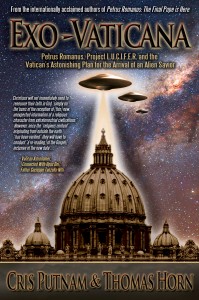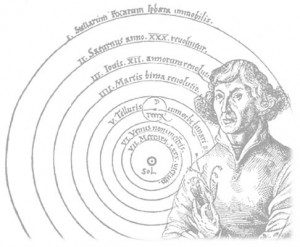My Coast debut with George Noory February 11, 2013!
COMING SOON!
Defending the Faith, Evangelizing the Eschaton
By Cris Putnam
 Pope Benedict announced today that he will step down at the end of the month. This is almost unprecedented as last to resign was Pope Gregory XII in 1415. He stepped down to end the “Western Schism,” a decades-long disagreement that resulted in two men claiming to be the head of the Catholic Church.
Pope Benedict announced today that he will step down at the end of the month. This is almost unprecedented as last to resign was Pope Gregory XII in 1415. He stepped down to end the “Western Schism,” a decades-long disagreement that resulted in two men claiming to be the head of the Catholic Church.
Back in April of 2012, Tom Horn and I revealed the obscure work of a Belgian Jesuit who predicted the final pope in April of 2012 based on a 900 year old prophecy by St. Malachy. I put all of his work on a spread sheet and calculated it all down to the days. See original post. Consequently, we were a little disappointed when it seemed like Rene Thibaut was mistaken.
As it turns out, he was far more correct than anyone ever knew! According to the NY Times:
That the resignation was long in the planning was confirmed by Giovanni Maria Vian, the editor of the Vatican newspaper, L’Osservatore Romano, who wrote on Monday that the pope’s decision “was taken many months ago,” after his trip to Mexico and Cuba in March 2012, “and kept with a reserve that no one could violate.”
Ny Times
I will be on Coast to Coast AM tonight to talk about this and our new project Exo-Vaticana. If you would like one of my few remaining copies personally signed you can order here.
Also see the promo for the out of this world followup EXO-VATICANA
By Cris D. Putnam (continued from part 3)
 In 1440, Nicholas of Cusa (1401–1464), a German philosopher, theologian, and astronomer, had a mystical experience while returning from Constantinople by ship. He described his vision thus, “When by what I believe was a celestial gift from the Father of Lights, from whom comes every perfect gift, I was led to embrace imcomprehensibles incomprehensibly in leaned ignorance, by transcending those incorruptible truths that can be humanly known.”[1] What followed was a treatise on mysticism entitled De Docta Ignorantia (“Of Learned Ignorance”). Similar to Buddhist practice, Nicholas called this “negative theology,” implying a sort of mystical knowing by not knowing. As a result, he conjured up hermetic platitudes like God is “a sphere of which the center is everywhere and the circumference nowhere.”[2] He believed that the limits of science could be transcended by means of mystic speculation. Some even contend that this preempted Kepler, famous for his laws of planetary motion, by arguing there were no perfect circles in the universe. His learned ignorance inevitably led him to other worlds inhabited by extraterrestrials.
In 1440, Nicholas of Cusa (1401–1464), a German philosopher, theologian, and astronomer, had a mystical experience while returning from Constantinople by ship. He described his vision thus, “When by what I believe was a celestial gift from the Father of Lights, from whom comes every perfect gift, I was led to embrace imcomprehensibles incomprehensibly in leaned ignorance, by transcending those incorruptible truths that can be humanly known.”[1] What followed was a treatise on mysticism entitled De Docta Ignorantia (“Of Learned Ignorance”). Similar to Buddhist practice, Nicholas called this “negative theology,” implying a sort of mystical knowing by not knowing. As a result, he conjured up hermetic platitudes like God is “a sphere of which the center is everywhere and the circumference nowhere.”[2] He believed that the limits of science could be transcended by means of mystic speculation. Some even contend that this preempted Kepler, famous for his laws of planetary motion, by arguing there were no perfect circles in the universe. His learned ignorance inevitably led him to other worlds inhabited by extraterrestrials.
Nicholas homogenized the heavenly bodies by dismissing the Aristotelian doctrine of unity and natural place. Therefore, he concluded that the Earth, planets, sun, and stars were composed of the same elements, and that there was no center of attraction. He envisioned an infinite universe, whose center was everywhere and circumference nowhere, containing countless rotating stars, the Earth merely being one of equal importance. Consequently, it is not too surprising that it is from Nicholas of Cusa that we encounter the first explicit Roman Catholic argumentation for the existence of extraterrestrials. In Of Learned Ignorance, chapter 12, he asserts:
Rather than think that so many stars and parts of the heaven are uninhabited and that this earth of ours alone is peopled—and that with beings, perhaps, of an inferior type—we will suppose that in every region there are inhabitants, differing in nature by rank and all owing their origin to God, who is the center and circumference of all stellar regions.[3]
Rather than the censure one might expect, Nicholas’ work was enthusiastically received. It is important to note that he stated this was revelation from God and it went unchallenged by the Church. Shortly after his shipboard vision, he had become the papal envoy to Pope Eugene IV and assisted in the papal power struggle against the council of Basel, opposing its attempt to reform widespread abuse. He was promoted to the status of cardinal by Pope Nicholas V in 1448. The next person of note was more inclined to science than mystic speculation.
Perhaps one of the greatest contributors to the discussion, Nicholas Copernicus (1473–1543), never actually addressed the  topic. Even so, his revolutionary work effectively removed the Earth from the center of the cosmos and seemingly relegated it one among many, perhaps similar, orbs revolving around the sun. He correctly surmised the apparent motion of the stars to be an illusion caused by the rotation of the Earth on its axis and that the Earth orbited the sun once every year. Of course, this meant that the countless stars were potential suns and the observable planets might be other “earths.” Of course, if there are other earths, then one might imagine they are populated with people or something else entirely. It really did change everything. Yet, heliocentricism was not widely accepted in his lifetime. A few astronomers, including Germans Michael Maestlin (1550–1631), Johannes Kepler (1571–1630), the Englishman Thomas Digges (1546–1595), and the Italian Galileo Galilei (1564–1642), accepted it, leading historians like N. R. Hanson to quip that the “Copernican revolution” was a minor skirmish that prompted the Keplerian or Galilerian revolution.[4] All the same, at the dawn of the Reformation, Copernicus had planted the seeds for an atomist revival replete with an alien invasion.
topic. Even so, his revolutionary work effectively removed the Earth from the center of the cosmos and seemingly relegated it one among many, perhaps similar, orbs revolving around the sun. He correctly surmised the apparent motion of the stars to be an illusion caused by the rotation of the Earth on its axis and that the Earth orbited the sun once every year. Of course, this meant that the countless stars were potential suns and the observable planets might be other “earths.” Of course, if there are other earths, then one might imagine they are populated with people or something else entirely. It really did change everything. Yet, heliocentricism was not widely accepted in his lifetime. A few astronomers, including Germans Michael Maestlin (1550–1631), Johannes Kepler (1571–1630), the Englishman Thomas Digges (1546–1595), and the Italian Galileo Galilei (1564–1642), accepted it, leading historians like N. R. Hanson to quip that the “Copernican revolution” was a minor skirmish that prompted the Keplerian or Galilerian revolution.[4] All the same, at the dawn of the Reformation, Copernicus had planted the seeds for an atomist revival replete with an alien invasion.
Next week… the infamous Giordano Bruno.
[1] “Letter to Cardinal Guliano Cesarini,” as quoted in Christopher M. Bellitto, Thomas M. Izbicki, and Gerald Christianson, Introducing Nicholas of Cusa: A Guide to a Renaissance Man (New York, NY: Paulist Press, 2004), 206.
[2] Peter M. J. Hess and Paul L. Allen, Catholicism and Science (Westport, CT: Greenwood, 2008), 22.
[3] Nicolas of Cusa, Of Learned Ignorance, translated by Germain Heron (London: Routledge and Kegan Paul, 1954), 111–118; as cited in Michael J. Crowe, The Extraterrestrial Life Debate, Antiquity to 1915: A Source Book (Notre Dame, IN: University of Notre Dame Press, 2008), 31.
[4] N. R. Hanson, “The Copernican Disturbance and the Keplerian Revolution,” Journal of the History of Ideas 22 (1961): 161–184; as cited in Michael J. Crowe, The Extraterrestrial Life Debate, 37.
 Did you know that there’s a telescope called L.U.C.I.F.E.R. built next to the Vatican’s observatory in Arizona? Now do you remember that the Catholic Church said it’s OK to believe in aliens and that they would even baptize one? So that leaves the big question: What if God and E.T. are the same thing? Tonight on Ground Zero, Clyde Lewis is joined again by researcher and documentarian Cris Putnam (previous episodes) to discuss his forthcoming film ‘Exo-Vaticana: Petrus Romanus, PROJECT L.U.C.I.F.E.R., and the Vatican’s Astonishing Exo-Theological Plan for the Arrival of an Alien Savior‘ and much more. This is not a second coming, this is ‘Exo-Cathedra: The Second Incarnation‘!
Did you know that there’s a telescope called L.U.C.I.F.E.R. built next to the Vatican’s observatory in Arizona? Now do you remember that the Catholic Church said it’s OK to believe in aliens and that they would even baptize one? So that leaves the big question: What if God and E.T. are the same thing? Tonight on Ground Zero, Clyde Lewis is joined again by researcher and documentarian Cris Putnam (previous episodes) to discuss his forthcoming film ‘Exo-Vaticana: Petrus Romanus, PROJECT L.U.C.I.F.E.R., and the Vatican’s Astonishing Exo-Theological Plan for the Arrival of an Alien Savior‘ and much more. This is not a second coming, this is ‘Exo-Cathedra: The Second Incarnation‘!
http://www.groundzero.fm/?p=episode&name=2013-02-06_20130205_groundzero.mp3
While I don’t agree with Clyde’s introductory monologue, we had a good interview and I was amazed that we found an astonishing similar plan to incarnate an savior figure via evolutionary mysticism associated with UFOS and aliens.
Amillennial
Antichrist
Apologetics
Apostasy
Armageddon
Atheism
Bart Ehrman
Bible
Chuck Missler
Creation
creationism
Cris D. Putnam
Cris Putnam
Cults
Daniel
Day of the Lord
End Times
Eschatology
Exo-Vaticana
Faith
Heresy
Heretic
Intelligent Design
Jesus
Joseph Smith
last days
Micheal Heiser
Millennium
Mormons
Petrus Romanus
Pluralism
Premillennial
Prophecy
Rapture
Resurrection
Resurrection Challenge
Revelation
Rob Skiba
Romanism
Russ Houck
Satan
Thomas Horn
Transhumanism
Trinity
UFO Apocalyptic Literature (2)
Apologetics (194)
Archeology (5)
Bible Exposition (23)
Bioethics (1)
Book Review (3)
Charity (1)
Conference (4)
Debate (3)
Eschatology (33)
Evolution (2)
Exo Vaticana (36)
Gender (1)
Hebrew Roots Movement (3)
Homosexuality (2)
Intelligent Design (8)
Interview (7)
Islam (2)
Movie Review (1)
My Books (8)
Nation Under Judgment (2)
NDE (1)
Occult (2)
On the Path of the Immortals (6)
Petrus Romanus (49)
Product Offer (1)
Putin (1)
Roman Catholicism (2)
Roman Catholocism (3)
Science (1)
Spiritual Warfare (5)
The Final Roman Emperor (3)
The Last Roman Emperor (1)
Theology (3)
Transhumanism (6)
TV appearances (8)
Uncategorized (3)
WP Cumulus Flash tag cloud by Roy Tanck requires Flash Player 9 or better.
Copyright © 2025 · Logos Apologia
